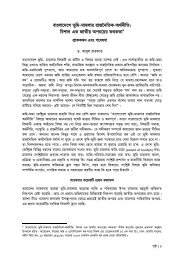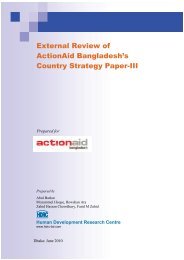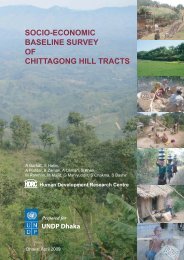08. Costing Essential Services Package An Issue Paper
08. Costing Essential Services Package An Issue Paper
08. Costing Essential Services Package An Issue Paper
You also want an ePaper? Increase the reach of your titles
YUMPU automatically turns print PDFs into web optimized ePapers that Google loves.
1. Background<br />
The International Conference on Population and Development (ICPD’94, Cairo Conference) has<br />
generated a new life-cycle based Reproductive Health (RH) concept, and broadened the base<br />
of health per se from family planning to clients’ unmet need oriented reproductive health. The<br />
strengths of the newly developed RH concept lies in the fact that it has added many more<br />
components into the population program beyond the traditional FP-MCH components. Among<br />
the newly developed components, important ones are RTI/STD, HIV, AIDS, adolescents health,<br />
women’s empowerment (with equality and equity), and violence against women. In addition, the<br />
unmet need for categories, such as adolescent, men, and displaced persons (including slum<br />
dwellers, refugees) were especially emphasized. Integration of all these into the newly<br />
designed program constitutes a major challenge to the policy makers and program<br />
implementators. The challenge of instituting a cost-effective public health system which will<br />
ensure higher gains in DALY (Disability-adjusted Life Year) has been proposed as an effective<br />
and socially acceptable approach to poverty reduction by the World Development Report 1993.<br />
WDR’93 has shown that public health and essential clinical services are highly cost effective –<br />
often costing substantially less than $ 50 per DALY gained. The content of the report influenced<br />
the national governments to think about necessary reform and restructuring of the national<br />
health sectors. As a result, the policy makers, in order to design the national program in<br />
accordance with the need of the time are confronting with the issues, such as costing Cairo or,<br />
in other words, costing of <strong>Essential</strong> <strong>Services</strong> <strong>Package</strong> (ESP) of the Health and Population<br />
Sector Program (HPSP, 1998-2003) in Bangladesh.<br />
Both necessity and interest in the estimation of the costs of ESP are increasing. It is important<br />
for the policy makers, planners, implementators and the academics to be aware of the different<br />
purposes for which cost and expenditure estimates 1> are required. The different purposes of<br />
costing include (1) projecting the financial and fiscal implications of the HPSP in order to assess<br />
the sustainability of the program, (2) investigating the technical efficiency of delivery of services<br />
through assessment of the impact of organizational and management changes, (3) identifying<br />
the allocative efficiency of the program by incorporating unit and marginal cost analyses into an<br />
assessment of the program’s impact on health status (i.e; the ratio of costs to health benefits, or<br />
DALYs gained).<br />
In the recent implementation of the <strong>Essential</strong> <strong>Services</strong> <strong>Package</strong> (ESP) Model, it became clear<br />
that appropriate and accurate cost information is essential for estimating resources required and<br />
1> `Cost’ and `expenditure’ are not the same concepts. `Cost’ is the value of a good or service, which is conceptually defined as<br />
the value that could be gained by using the resource in a different way, while `expenditures’ refer to the amount of money,<br />
time, or effort spent or expense payments made in cash or checks. It is important to note that costs are often usually thought<br />
of in terms of money paid for resources used, but there is a broader way of looking at costs that can be useful in some cases.<br />
The basic idea is that things have a value that might not be fully captured in their price. That is as true of health services as it<br />
is of friendship, or of pleasant views. It is not difficult in many health programs to identify some resource inputs for which little<br />
or no money is paid: volunteers working without payment; health messages broadcast without charge; vaccines or other<br />
supplies donated or provided at a large discount by organizations or individuals. Should we say that those inputs cost little or<br />
nothing? The answer depends on what we are interested in. For some purposes, there is no need to take unpaid-for<br />
resources into account. This is true, for example, if our concern is solely to determine how much of a financial budget<br />
allocation should actually be spent. Resources for which client pays nothing do not appear as expenditure and can be ignored<br />
(i.e., their financial cost is zero). However, if we are concerned with the long-term sustainability of our program, the total cost of<br />
paying for all of its inputs – even those temporarily provided by donors or paid for at less than market rates – must be<br />
estimated. Economists use the terms “opportunity cost” or “economic cost” to describe this approach to costing. It recognizes<br />
that, even if no money is spent, the cost of using resources that could have been productively used elsewhere. <strong>An</strong>alyses using<br />
economic costs do not replace studies done with financial costs, but supplement financial cost analysis with additional<br />
information useful for decision making (for details see: Reynolds J 1993, Miller J and C Bahamon 1996, Creese A and D<br />
Parker (eds) (undated), Green A 1997).






